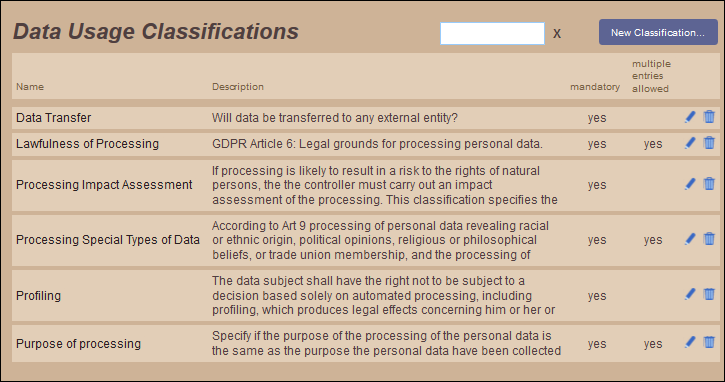Data Usage Classifications
How a processing activity uses a data category is defined through data usage classifications. A single data category might be used by more than one processing activity, with each processing activity using the data category in a different way. The procedure works as follows: (i) A number of data usage classifications are configured at system level, for each of which a set of allowed values are defined; (ii) When a data category's usage by a processing activity is defined, one or more allowed values for each data usage classification are selected.
In this section, we describe how to configure the system-level data usage classifications. For a description of how to assign a value to a data usage classification when a data category's usage by a processing activity is defined (its usage definition), see the section Define Processing Activities.
Manage data usage classifications
The Data Usage Classifications page (screenshot below) enables you to manage data usage classifications: that is, (i) to create a new data usage classification (by clicking New Classification), (ii) to edit a data usage classification (by clicking the Edit icon of a classification), and (iii) to delete a data usage classification (by clicking the Delete icon of a classification).

When you add a new classification or edit a classification, a page with the classification's definition is displayed (see below). On this page, you can edit the definition of the selected data usage classification.
Edit a data usage classification
The definition of a data usage classification consists of two parts (see screenshot below): (i) fields that describe and comment on the classification, and (ii) a list of the values of the classification.
Note the following:
•If you want a data usage classification to be mandatory (in the definition of the usage of a data category by a processing activity), check the classification's Mandatory value check box. If a classification is mandatory, then a value must be selected for this data usage classification when defining the usage of every data category.
•If a data usage classification can take multiple values—for example, when describing on what grounds health-related or race-related data may be legally processed—then check the Multiple values allowed check box. This enables multiple values to be specified for this data usage classification when it is used in the definition of a data category's usage by a processing activity.
•If a data usage classification is marked as Obsolete (in the Classification Description pane), then that classification is not available for selection in new definitions of the usage of data categories in processing activities. Usage definitions that were created prior to the classification being marked as obsolete will continue to have the classification in their definitions.
•To append a classification value, click New value (see screenshot above) and, in the new field that appears, enter the value and a description of it. Alternatively, to insert a value above an existing value, click the Plus icon of the existing value. You can enter as many classification values as you like. The values defined here are the allowed values. One value (or more, if multiple values are allowed; see above) can be selected when the classification is used in the definition of a category's usage by a processing activity.
•If a value is marked as Obsolete, then that value cannot be selected from this point onwards in both existing usage definitions and new usage definitions.
•After you finish editing a data usage classification, click Save to save the changes.
Relationships with other metadata
A Data usage classification has the following relationships with other metadata:
It can be selected for... | Which sets up... |
The definition of the data category's usage by the processing activity. |
